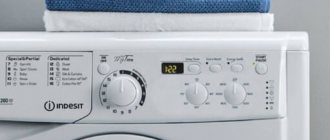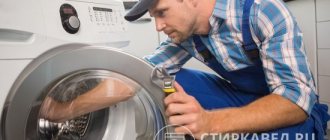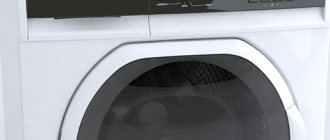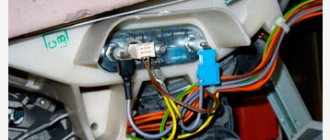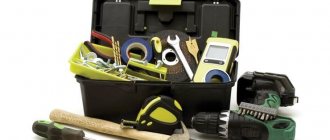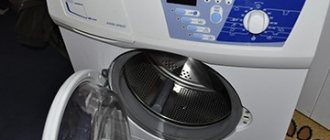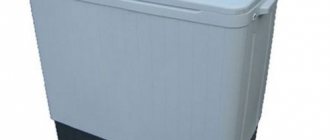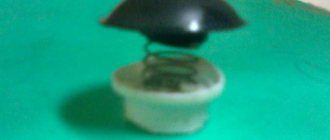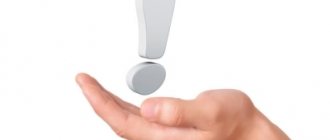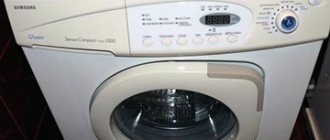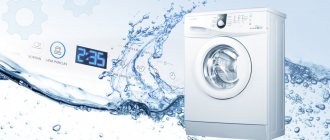Washing machines are very popular household appliances that can be found in many homes. This is not surprising, because washing machines help us always keep our clothes clean, which is very important. But, like other equipment, they break down periodically, and this applies even to very high-quality models from well-known manufacturers.
Call a specialist
If you are faced with a similar problem, then repair Samsung s821 washing machines
, which our company offers, is an excellent solution for you.
The main breakdowns of washing machines of this line
Models of washing machines 821, s803j, s852, s621, s1021, s1043, from the famous Korean manufacturer Samsung, are among the most popular devices in this market. This is quite obvious, because they have good technical parameters, can also please customers with various advanced functions, and are simply made very well.
Repair of washing machines Samsung s852
However, they are also not immune from possible problems, and when this happens, repair of Samsung s852 washing machines,
which our company offers can be more useful than ever. Among the main breakdowns that are most typical for devices of this model line, the following should be noted:
— The water stopped heating
Main components of a washing machine
Schematically, the device of a Samsung washing machine can be represented as follows:
- On the front side: control panel, powder receiver, drain pump with hose, filter.
- On the cover side: inlet valve, level switch, tank suspension springs, counterweight.
- Side: tank, shock absorber
- From the back: drive belt, electric motor, pulley, power cord, drain hose.
You need to know the location of the main components in order to get to the desired unit as quickly as possible in the event of a breakdown. To eliminate the malfunction, you may also need an electrical circuit of the washing machine.
Causes of malfunctions and methods for eliminating them
The main part of the faults can be divided into groups depending on the causes of the breakdowns and how to eliminate them.
Washing machine won't turn on
The reasons why the device does not start up may be the following:
- The hatch is not closed.
- The power cord is broken.
- The control unit has failed.
- The socket is faulty.
- The engine has failed.
- The power button does not work.
- There is no electric current.
If the machine does not react in any way when turned on, first of all, you should check the presence of electricity, the socket and the cable. The power cord must be inspected for mechanical damage, insulation damage, contact oxidation and tested using a multimeter. If a malfunction is detected, the cord is replaced with a similar one. The easiest way to check an outlet is to simply connect another, known working device into it.
If the washing machine's hatch is not closed, the indicators on the control panel light up, and in models with a display, an error code is visible on the screen - to fix the problem, just open the door and slam it forcefully again until it clicks.
If there is power, but when you press the button the program does not start, perhaps the problem lies in the button itself. It is necessary to ring its contacts while it is on. If resistance does not appear, the button should be replaced.
The control unit (board) and the engine cannot be repaired at home; you will have to contact a service center. In addition, these parts are quite expensive.
Water does not fill
There may be several reasons why water is not collected or flows too slowly:
- The network pressure is below the minimum.
- The inlet filter is clogged.
- The inlet valve or control module has failed.
If the pressure is too low (this happens in private houses or high-rise buildings on the upper floors), the machine will draw water slowly or intermittently. In this case, it is worth taking care to install equipment that can maintain the required pressure or wash at night, when it is higher in the network.
Another probable reason for the lack of water is that there is a shut-off valve on the pipe that shuts it off completely or partially.
To clean the inlet filter, you need to unscrew the inlet hose, remove the mesh, go over it several times with a brush, rinse in clean water and put it back in place.
A broken intake valve is a serious problem that requires qualified repairs. You can replace it according to the following scheme:
- unplug the washing machine and remove the back cover;
- disconnect the wires leading to the valve, tighten the pipes secured with clamps, unscrew the inlet hose;
- remove the faulty part and replace it with a similar one;
- connect the wires and tubes in the reverse order;
- check the performance of the system.
Failure of the control module, in this case, also requires the intervention of a qualified specialist.
Doesn't drain water
There are two main reasons why the washing machine does not drain the water at the end of the wash:
- The drainage system is clogged.
- The pump has failed.
Before you begin repairing the drain pump, you need to clean the drain system. To do this, you need to open the panel at the bottom of the facade. If the washing unit is equipped with an emergency drain tube, pull it out, open it and drain the dirty water. If not, place a flat container under the filter and carefully unscrew the lid. Remove all debris from the opened hole and turn the pump impeller - it should rotate freely.
If the blockage is severe, in addition to the pump, the drain pipe and hose may become clogged. You can clean the listed parts yourself using the following scheme:
- lay the machine horizontally and remove the protection at the bottom;
- unscrew the clamp that holds the pipe, unhook the plug from the pump sensor, disconnect the fastening elements;
- pull out the pump, unscrew the drain hose and rinse them with hot water under pressure.
If the problem is not a clog, you need to diagnose the drain pump. The pump is inspected for external damage. Possible causes of malfunctions:
- the impeller has fallen off the axis or cracked;
- the casing was deformed from hot water;
- the integrity of the motor windings is compromised (the contacts ring with a multimeter);
- rubber seals are torn.
Rubber gaskets and impeller are replaced with new ones. If, due to the loss of the geometry of the casing, the blades begin to touch its surface, you can trim them a little (literally 1 mm). To accurately assemble the pump circuit in reverse order, it is worth photographing the assembly.
Water flows
If your washer is leaking water, you need to find the source of the leak.
- Moisture accumulates under the bottom - the hoses (drain and filler), drain pipe, and tank could burst.
- There are leaks under the hatch - the cuff may be damaged.
The cause of the leak is sought sequentially, checking each node. If a place of depressurization is detected, the faulty part is replaced.
The drum does not rotate
There may be several reasons why the washing machine does not work and does not rotate the drum:
- The drive belt has fallen off.
- The bearing has failed.
- There is a foreign object stuck in the tank that is preventing the drum from moving.
You can check the integrity of the belt by turning the car over and removing the protection from the bottom. Bearing failure is preceded by a loud knocking and grinding noise that accompanies the operation of the unit for a long time.
The machine does not heat the water
If a malfunction occurs, the machine continues to operate, but all laundry is washed in cold water.
There are three main reasons for the malfunction:
- The heating element has failed.
- Thermostat is faulty.
- Problems with the control module.
The heating element may fail due to a thick layer of scale formed over years of service. Change the heating element in the following sequence:
- remove the front panel of the device;
- disconnect the wires leading to the heating element located at the bottom of the tank;
- dismantle the heater by unscrewing the fasteners holding it, disconnect the temperature sensor;
- gently tapping, pull out the stuck heating element;
- test the part with a multimeter, if the resistance is extremely low, replace it with a new one.
- install a new heating element, having previously cleaned the installation site.
Not only the heater can break, but also the thermostat. In this case, the machine may not heat the water or, conversely, wash clothes in hot water, regardless of the selected mode.
Noise when the washing machine is running
A strong hum or knock heard when the unit is operating may indicate bearing failure. The most common cause of malfunctions is wear of the seals.
Change them in the following sequence:
- disconnect the machine from the network and water supply, remove the top cover;
- disconnect the hoses, remove the tray, unscrew the counterweight;
- remove the rubber band of the hatch, having previously disconnected the latch;
- unscrew the lid at the bottom;
- dismantle the engine and drain pump;
- unscrew the fill valve, remove the springs holding the tank;
- remove the tank and, having removed the brackets and clamps, remove its upper part, opening access to the bearings;
- carefully knock out the bearings, replace the seals with new ones, pre-lubricated with oil;
- Press in the bearings and reassemble the machine in the reverse order.
Strengths and weaknesses of Samsung washing equipment
Samsung washing equipment is deservedly popular. For example, the new Diamond series, with a load of 5 and 6 kg, has unique useful innovations, including a small cell drum, Aqua Stop and Volt Control systems. Bubble washing technology - Eco Bubble - allows you to wash your laundry more efficiently.
Models such as Bio Compact S821 , Sensor Compact S803 J , WF- R1061 and WF- F861 have received high marks from Russians, as they have been serving their owners well for more than 10 years and are highly reliable.
Breakdowns of Samsung washing machines often occur due to violations of operating rules. In addition, some details are problematic , which include:
Heating elements fail due to too hard water, which forms scale. Poor quality of tap water and improper operation lead to blockages and breakdowns in drainage and water intake systems. These are the data from long-term statistics of leading service centers. But electronics are the strong point of Samsung SM and rarely require repairs.
Samsung washing machine error codes
It is much easier to determine damage if there is a display on the control panel. In case of malfunctions, symbols are displayed on it, each of which corresponds to a specific breakdown.
| Basic error codes | Corresponding fault |
| 4C | Water does not fill or fills too slowly (the filling process takes more than 20 minutes) |
| 4С2 | Make sure that the inlet hose is connected to the cold water pipe |
| A0,B0,C0,D0,E0 | Diagnostics of the washing machine is enabled (test mode, which is used at the factory) |
| 5C, 5E, E2 | Water does not drain |
| dC | Door is open |
| O.C. | Excess water, you should spin the machine and restart it |
| LC,LC1 | Problems with the inlet hose |
| Ub | Spin does not work |
| U.C. | No power supply, low voltage, check connection |
| 3C | Engine doesn't work |
| NS | The heating temperature has been exceeded; the thermostat may be faulty |
| 1C | The water level sensor is not working correctly |
| DDC,ddC | Appears if the Add Door (for loading forgotten laundry) is opened without pressing the Start or Pause button. |
| DC3 | Add Door lock does not work correctly |
| Sd | Too much foam |
| DC1 | The main door lock did not work correctly |
| Sun | The unit cannot start the engine |
| PoF | There was a power outage during the washing process |
| Hot | During the drying process, the temperature inside the drum exceeded 700C |
| LE,LC,E9 | Spontaneous drainage of water due to a low-lying hose or a leak. |
Please note that the listed fault codes are periodically modified and new ones are added. Therefore, before starting repair work, you should check the list of errors specified in the instructions.
Source
Common Mistakes
Errors in the water level sensor (pressostat)
For different Samsung washing machine models, the error codes indicating the same problem may vary. For example, errors associated with a malfunction of the water level sensor (pressostat) for the oldest models will be indicated by code 1EE7 , for more modern models, for example, “Diamond”, “Eco Bubble” - E7 , 1C , 1E . If you have a Samsung washing machine made in the USA, then error 1E will be indicated as error LE .
The pressure switch in the washing machine detects the water level and sends a corresponding signal to the control module. Errors associated with its malfunction include the loss of such a connection or incorrect operation of the element itself. You need to look for the causes of the error in the following:
E1 is displayed, the washing machine usually automatically turns on the forced drain of water after 3 minutes.
You can eliminate possible causes of malfunctions as follows:
Motor tachometer errors
Another important element of the washing machine is the tachometer (tachogenerator), which controls the rotation frequency of the drum. If it malfunctions, the number of revolutions does not correspond to the specified washing mode, and the machine may be damaged as a result of excessive rotation. The opposite situation is also possible - irregularities when loading the machine or foreign objects can block the operation of the device.
The tachometer controls the rotation speed of the electric motor.
In modern Samsung models, tachometer errors are indicated by codes 3E ( 3C4, 3C3, 3C2, 3C1, 3C, 3E4, 3E3, 3E2, 3E1 ), in older ones - EA , EB , 8E .
The most common reasons for these errors appearing on the washing machine display are as follows:
To eliminate possible malfunctions, the first step is to completely unload all the laundry from the washing machine. If malfunctions were associated with overload, then after turning the machine on and off, the error should disappear. More serious problems related to wiring, sensor or motor faults will be much more difficult to fix on your own. If you are confident in your abilities, check the engine for foreign objects and remove them, inspect the wiring and contacts.
Water supply problems
In this section we will talk about problems associated with insufficient or excessive water supply and improper heating.
Errors caused by such problems are indicated by codes E1, 4C2, 4C, 4E2, 4E and 4E1 .
There may be several reasons for improper water flow:
To eliminate violations, you need to:
Washing machine hatch errors
If the washing machine door refuses to close or open, it is usually noticeable without prompting on the display. Errors associated with hatch damage are displayed on the screen with codes ED , DC2 , DC1 , DC , dE2 , dE1 , dE .
The hatch may break for the following reasons:
If you haven't closed the car door tightly or clothes are caught in it, the problem is easy to fix: open the door, put things in the drum and close the hatch tightly until it clicks. Sometimes, in order to “remove” the error, you need to turn off and turn on the machine, and then start the wash.
With a door that cannot be opened, the situation is more complicated: it is better not to fix such a breakdown yourself, but to contact a repairman. A malfunction in the control module can sometimes be resolved by turning off and then turning on the washing machine.
Water leak
Water leak error codes can appear on the display either when there is a real loss of water or when the sensor is broken and transmits an incorrect signal to the control module. Information codes for this error are E9, LC, LE1 and LE.
The causes of the malfunction can be very different:
Before you begin inspecting the washing machine, be sure to disconnect it from the power supply. Then check the integrity of the hoses, seals, filter and their attachment points. If you are unable to identify the problem yourself, it is better to contact a specialist.
Error 5d, 5ud , error Sud , as well as SD , SUdS , are associated with excessive foam formation. The reasons for such a malfunction in the operation of the unit may be the following:
If you notice foam flowing from the washing machine, you urgently need to unplug it, remove all items from the drum, rinse the powder compartment, the filter and the drum itself.
Imbalance Errors
E4 , UB or UE appear on the display of the washing machine , this means that there is an imbalance in the washing machine.
The reasons for this phenomenon are:
This error does not require calling a technician and can be resolved independently. It is necessary to evenly distribute the laundry inside the drum and avoid overloading the washing machine. Manufacturers do not recommend loading the drum completely, either in terms of volume or weight of laundry.
In the instructions for each individual washing machine model you can find recommendations on how to balance the washing machine itself. You can do this yourself without calling a specialist.
Heating element errors
Another important element of the washing machine is the heating element (tubular electric heater), which heats the washing water to the desired temperature. If there are errors in its operation, codes E6, E5, HC2, HC1, HC, H2, H1, HE3, HE2, HE1 and HE .
The causes of heating element failure are often increased water hardness and lime deposits. When the heating element is covered with a thick layer of limestone, it stops heating the water and overheats itself, and then fails. You can prevent an unpleasant situation if you use special water softeners and periodically clean the washing machine, for example, using citric acid. (How to do this correctly, read this article.)
Other causes of heating element failure may be related to:
It is not recommended to independently repair malfunctions associated with heating element breakdowns. The only thing you can do is check whether the washing machine is connected to the network correctly.
Vibration sensor malfunctions
If the vibration sensor does not work correctly or does not send a signal to the washing machine control module at all, codes 8C1, 8C, 8E or 8E1 .
In this case, you can independently inspect the sensor and check the integrity of the electrical wiring connecting it to the control module. If the device is faulty, it must be replaced.
Power supply problems
If the voltage in the electrical network does not meet the parameters necessary for the correct operation of the washing machine, codes 9C , 9E2 , E91 or UC .
The reasons for malfunctions may be different:
Usually, the appearance of the above codes does not require intervention in the operation of the machine - you just need to wait until the power supply stabilizes. To protect the device from power surges, you can connect a stabilizer.
The machine takes in too much water
Excess water collected in the washing tank is reflected on the display with codes E3, 0C, 0F or 0E . The reasons may be:
You can remove excess water by turning off the machine, placing the drain hose in the bathtub and running the wash again.
